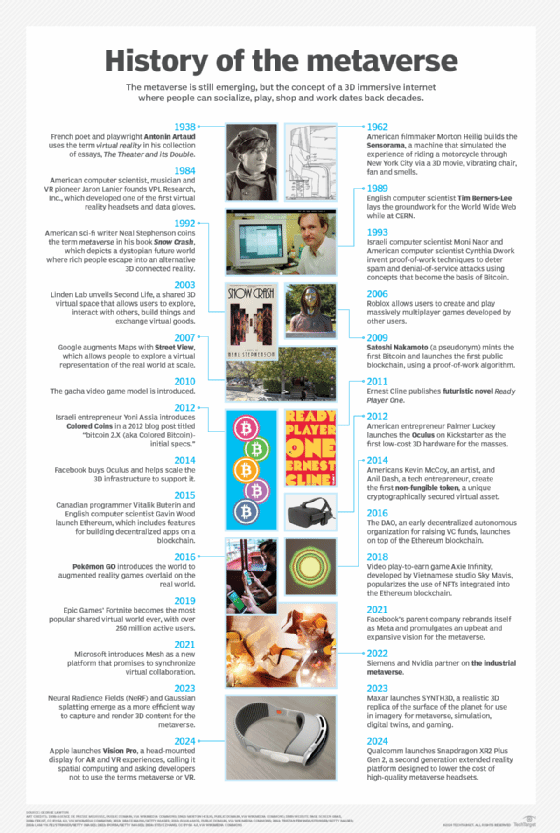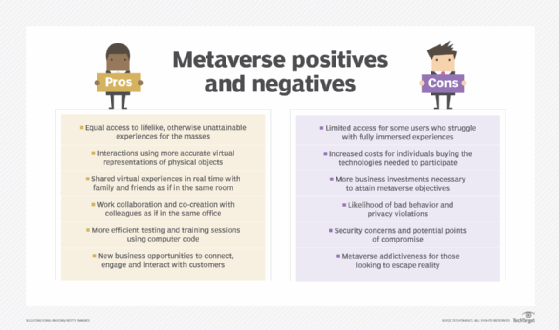17 real-world use cases of the metaverse, plus examples
Use cases for the still-developing metaverse are growing as the technologies that enable this next iteration of the internet mature. Here are 17 examples of enterprises and consumers.
The promise and benefits of an interconnected virtual world – commonly labeled the "metaverse" are still highly anticipated.
However, the technologies that enable the metaverse -- from AI to smart goggles -- are advancing and bringing it closer to reality -- and eventually to widespread use, according to Samantha G. Wolfe, founder of marketing consultancy PitchFWD, an adjunct professor at the NYU Steinhardt School, and co-author of Metaversed: See Beyond the Hype.
Wolfe said people are still getting a grasp on what these technologies can and will do.
"There is/was a lot of misunderstanding in the market that the metaverse is/was a 2-dimensional gaming platform, like Fortnite. Those kinds of online multiplayer experiences do demonstrate what could be possible within a 3D digital world, but they aren't technically the definition of the future metaverse," Wolfe said. "The technologies that are necessary to have a real time, global interconnected vision of the metaverse are still being developed (e.g., 6G, advanced AI), and they are converging and integrating with one another (e.g., advanced smart glasses, driverless vehicles). This is why the 'metaverse' isn't here yet. We still have a long way to go."
In fact, Wolfe said the term “metaverse” itself “has fallen out of fashion, initially due to the popularity of the term ‘spatial computing’ and then due to the massive hype around various forms of artificial intelligence. (The word ‘metaverse’ was coined by sci-fi author Neal Stephenson in his 1992 novel Snow Crash.)
Regardless of the terms used, Wolfe said virtual world experiences are gaining traction as the technology matures.
"The advancement of an interconnected, multidimensional global network of technologies is still happening," Wolfe said.
When all that comes together, the impact will be significant, she added.
"When everything can be augmented, when we can walk into a virtual reality anywhere and anytime we want … it's going to change everything, just like the internet," Wolfe added.
Although that vision of the metaverse is still a ways off, many use cases for this next iteration of the internet have emerged. From virtual conferences and collaborative workspaces to immersive education and new retail experiences, the metaverse is already demonstrating its potential.
"Enterprise pilots in immersive training, use of digital twins for simulation and prototyping and AR-supported retail experiences continue to expand in manufacturing, infrastructure and retail," said Manjeet Rege, professor and chairman of the department of software engineering and data science at the University of St. Thomas and director of its Center for Applied Artificial Intelligence.
Here are 17 existing and maturing use cases worth knowing about.
 Glenn Platt
Glenn Platt
1. Gaming
Gaming is among the earliest and most prevalent uses of the metaverse, said Glenn Platt, professor of interactive media studies at Miami University's Farmer School of Business. There are several reasons why gaming platforms lead in metaverse adoption. Many gamers already have the necessary hardware to engage with the metaverse, and they've shown a greater enthusiasm for metaverse experiences. Additionally, gaming companies have outpaced other metaverse platforms in developing immersive content and experiences. The historical popularity of Second Life, Roblox and Minecraft attests to that.
 Samantha G. Wolfe
Samantha G. Wolfe
2. Augmented and virtual events
People also come together to enjoy events, particularly live-like shows such as concerts, "where people can feel a vague sense of presence and of being together even if they're not physically together," Wolfe said.
Performers including Travis Scott and Ariana Grande have made their way into the metaverse, teaming up with Epic Games to offer fans the option of seeing them in concert within Fortnite.
Experts said they expect to see more immersive events, such as football games and other sporting matches, in the future.
"Advancements in technology have created opportunities to gamify physical event locations and augment theatrical performances. These experiences can now happen on a more personalized level with higher quality graphics at a larger scale, where ticket holders use their smartphones like game controllers across a large-scale physical location (e.g., LA Rams activation by ARound)," Wolfe added.
 Chris Johnson
Chris Johnson
3. Immersive entertainment
Similarly, the metaverse enables new types of entertainment experiences, facilitated by "new ways of engaging and collaborating," said Chris Johnson, a partner at management consulting firm Bain and co-leader of the firm's Global Technology/Strategy interlock. Pokémon Go, an augmented reality (AR) mobile game, was released in 2016 as a prototype of the kind of entertainment the metaverse eventually will deliver. Some people expect the metaverse to enable immersive 3D storytelling, the next generation of transmedia -- something that today uses video, text and games to tell a story in two dimensions.
4. More effective training
Training is another big use case for the metaverse, with many organizations already using the technology to train their workers, said Allan Cook, a managing director with Deloitte Digital.
"Immersive training continues to be the most prevalent for enterprise," Cook added.
The metaverse replicates hands-on experiences, which have been proven to be more effective for training than content delivered using lectures, text or video. It also enables trainees to repeat a task until they've mastered it -- with no wasted resources -- and it enables workers to revisit training as needed for refreshers or practice. For example, surgeons use the metaverse to practice complex surgeries before they perform them on actual patients.
 Allan Cook
Allan Cook
Additionally, the metaverse creates realistic versions of work scenarios; for example, it can simulate a construction site to teach workers how to stay safe in various situations. Furthermore, the metaverse allows workers to train for the extraordinary -- such as a fire on an oil rig in the ocean -- enabling them to build (in a safe environment and at a reasonable cost) the muscle memory required to handle such rare events.
"If training is too difficult, too expensive or too dangerous to do in the real world, why wouldn't you do it in an immersive one," said Cook, Deloitte's Digital Reality Business leader, who works with clients on virtual reality (VR), AR, mixed reality, and immersive strategies and experiences.
5. Next-generation education
Workers aren't the only ones who will benefit from learning in the metaverse. Platt said that students of varying ages will likely have lessons delivered using metaverse-type experiences in the future.
Additionally, Cook said the metaverse could bring gaming to those lessons, creating "edutainment" offerings, which research has shown to be more engaging and more effective in making lessons stick. "The best way to learn is to do something enjoyable," he added.
6. Real-time virtual expert assistance
Wolfe said she expects the metaverse to enable people in all sorts of circumstances to gain real-time expert assistance. Such experiences already exist in limited areas, with companies using AR and VR to superimpose written instructions or video directions in workers' fields of vision as they perform tasks that require such guidance.
Furthermore, some companies use metaverse-type technology to pair remote experts with field workers, giving those remote experts a view of what the workers are seeing and doing in the field so they can better guide those field workers through their jobs. Wolfe said people might someday have regular access to expert guidance for routine tasks, such as changing car tires.
7. Virtual tourism and a world without geographic barriers
One of the most promising use cases, according to multiple experts, is the creation of an environment that eliminates geographic boundaries. Tourism is a big use case, they said, with the opportunity to explore nearby and far-flung locales when real-world travel isn't an option.
The metaverse can also bridge geographic distances for friends and family members who can't physically be at big events -- parties, graduations, weddings, etc. The metaverse would let them attend such events almost as if they were there in person (versus just viewing pictures or a televised version), Platt explained.
8. A new world for socializing
The metaverse, however, could offer an environment that's closer to real-life social situations, where avatars can move around to interact with different individuals and groups, Wolfe said, noting that AI will play a significant role in the experience.
"Virtual worlds make socializing feel closer to real life, where you move your avatar around in space to talk to other people's avatars. But the avatars you meet might not actually be real people. They may be super-advanced conversational AI, virtual beings that don't exist in reality, similar to non-player characters (NPCs) in gaming. Although, as of now, it's obvious who is real versus who is not in virtual spaces, that distinction has started to become less apparent," Wolfe said.
Platforms such as Second Life already offer a version of such experiences, with experts adding that individuals beyond gamers may feel more comfortable socializing in digital spaces as metaverse-enabling technologies evolve in the future.
9. Imagination enablement
The metaverse can bring abstract ideas to life, Platt says. Consider, for example, how developers and architects have traditionally showcased new buildings using small-scale models. Imagine, instead, if they used the metaverse to bring visitors into an immersive world where they could see the finished structure in the proposed location. They could walk visitors through the building and even show them behind-the-scenes views of the utilities or structural designs.
 Geoffrey Long
Geoffrey Long
10. Explorations of what-if scenarios
Similarly, the metaverse allows people to explore what-if scenarios in a more immersive way, said Geoffrey Long, an assistant professor in the Department of Emerging Technology in Business and Design at Miami University and director of its Games and Simulation program. Climate scientists, for example, could partner with urban planners to simulate how their cities would be affected by a 50-year storm and a 100-year storm and then how their cities could fare better in those scenarios if they implemented various storm-mitigation strategies.
"Game technologies like chess sets and sandboxes have been used for real-world simulations since early 19th-century Prussia, but now teams can use modern video game engines, real time data, AI and XR hardware to experience their simulations firsthand in the metaverse," Long explained.

11. Exploration of environments off-limits to humans
This use case goes beyond tourism, Platt said. Rather, he said the metaverse could be used to create visibility and exploration of spaces that would otherwise be invisible.
"The metaverse is really good at revealing hidden data, things that are not easily engaged with in real life because maybe they're too big or too small to see, like being inside a cell," Platt explained.
He said he worked with a hospital system to create a metaverse training experience designed to immerse clinicians in a patient room that -- thanks to digital technologies -- illuminated all the infectious germs that typically exist in such spaces "to reveal the thing we don't see" yet still need to know is present.
12. Better collaboration
The widescale shift to remote work and video conferencing for team meetings likewise exposed limits to that technology for collaboration, Platt said, noting that "it's hard to get body language cues or engage with physical objects" in that 2D space. The metaverse, however, could address these limitations as it would allow for more lifelike engagement with others and, using haptic technology, enable people to interact with digital objects in a physical way.
13. More efficient R&D, design and prototyping
Companies of all kinds already use digital twins for research and development, design, prototyping and testing, experts said.
Carmakers, for example, create new designs and test features in virtual spaces; aerospace companies do the same for their products. Rege pointed to BMW's deployment of Nvidia Omniverse across its production network as an example, noting that it "enables virtual planning of factory layouts, workflows, robot placement and collision checks before construction or tool deployment. That use case alone is expected to cut factory planning costs by about 30% and accelerate launch of new models across 30-plus sites."
Rege also said retailers are using metaverse technology to replicate their retail locations "in a virtual twin environment to simulate store layout changes shelf configurations and customer flow before making physical changes" – a use case that helps retailers optimize merchandising staffing and logistics.
Metaverse technologies are also being used to create digital twins of large-scale infrastructure projects, Rege said. He cited DXC Technology's work with ISA Vías in Chile to create a digital twin of the road network, enabling the planning of traffic management and emergency scenarios. "Finally, large-scale data and studies of intelligent twin plus AI systems show maintenance predictive accuracy and efficiency gains consistent with leading enterprise AI projects," he explained.
Experts expect more companies across various industries to undertake such work as the metaverse matures, enabling them to perform tasks at a fraction of the time and cost required for R&D, design, and testing in the real world with real materials.

14. Immersive participation
The metaverse can move people from spectator to participant, sources said. Someone can try ziplining in the virtual world and experience sensations similar to the real deal, perhaps to test their mettle before trying the activity in real life, Cook said. People could opt to feel what it's like to drive a race car or run the court in a pro basketball game, with the metaverse delivering an immersive experience that goes well beyond watching such events on a 2D screen.
 Manjeet Rege
Manjeet Rege
15. A new retail experience
Retailers now deliver some early metaverse-like experiences, offering customers a way to see how eyeglasses or other items look on them or how a couch looks in their homes. The metaverse will amp up and expand such experiences, Rege said. A cruise ship company could let prospective customers tour the various cabin options to determine which would be the best option to book. Real estate agents could use the metaverse to routinely give tours of properties to prospective buyers. Carmakers could let prospective buyers test vehicles with different features and see how they'd look in different color models.
16. New market opportunities
Video game companies sell add-ons, skins and other virtual items to gamers. Apparel designers sell digital clothes and accessories in existing metaverse experiences, too, Cook said. That, though, could be just the start of new and expanded market opportunities. Cook said he anticipates that businesses and entrepreneurs will identify new market opportunities as the metaverse continues to evolve and more people engage with it.
17. Yet-to-be-imagined possibilities
Although experts have varying definitions of the metaverse -- and debate whether the technology as it exists today truly constitutes the metaverse -- they agree that the current technology is at an early stage. As such, they also agreed that there are use cases for the metaverse that have yet to be imagined. As Wolfe said, "We don't know all the use cases yet, but one of the best parts of working with emerging technologies is imagining the opportunities of these advancing and converging technologies and then seeing how everyone uses them to create the future."
Examples of gaming in the metaverse
One of the largest use cases for metaverse technologies is in the gaming industry.
"It continues to grow as [people] become more used to spatial technologies and as the hardware continues to evolve," Cook said, adding that "gaming is one of the most prevalent use cases in general."
Indeed, the gaming segment of the metaverse is experiencing explosive growth, Rege added.
Market research backs that up -- Mordor Intelligence put the gaming market at USD 25.67 billion in 2025 and estimates that it will grow to USD 137.96 billion by 2030, "registering a vigorous 40.02%" compound annual growth rate.
"Surging adoption of VR and AR headsets, the roll-out of high-speed 5G, tokenized economies, and multibillion-dollar alliances between entertainment IP owners and game platforms are powering this ascent. Hardware still brings in most revenue, yet software and services now outpace it as creators monetize avatars, live events, and play-to-earn loops," Mordor Intelligence wrote in releasing its figures.
According to Rege, "gaming platforms such as Roblox and Fortnite engage hundreds of millions of users monthly, far eclipsing enterprise metaverse pilots in terms of scale and revenue."
He said several platforms define the gaming metaverse landscape in 2025, noting that "Roblox supports a massive creator economy." Roblox reported 111.8 million daily active users in its Q2 2025 earnings report, which is up 41% year-over-year.
Rege added, "Fortnite, now more than a shooter game, hosts virtual concerts, branded experiences, and is evolving using Unreal Engine 6 toward interoperable, cross-platform ecosystems."
He said the ecosystem is dominated "by major players shaping both content and infrastructure" and cited Roblox Corp., Epic Games (Fortnite / Unreal Engine) and Animoca Brands (The Sandbox) as leading platforms. He also said Meta Horizon "continues to play a role in social and VR gaming contexts."
Meanwhile, Rege said on the infrastructure side that "Nvidia provides metaverse‑capable tools using Omniverse, while engine and AR/VR development is supported by companies such as Unity Software, Microsoft, Tencent and Sony."
Mary K. Pratt is an award-winning freelance journalist with a focus on covering enterprise IT and cybersecurity management.








